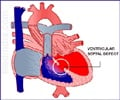A new nanoscale scanning technique developed at Imperial College London has enabled researchers have been able to see how heart failure affects the surface of an individual heart muscle cell
A new nanoscale scanning technique developed at Imperial College London has enabled researchers have been able to see how heart failure affects the surface of an individual heart muscle cell in minute detail.
The findings may lead to better design of beta-blockers, the drugs that can slow the development of heart failure, and to improvements in current therapeutic approaches to treating heart failure and abnormal heart rhythms.Heart failure is a progressive and serious condition in which the heart is unable to supply adequate blood flow to meet the body's needs. Hormones such as adrenaline, which are activated by the body in an attempt to stimulate the weak heart, eventually produce further damage and deterioration. Symptoms include shortness of breath, difficulty in exercising and swollen feet.
In the new study, published today in the journal Science and funded by the Wellcome Trust and the Leducq Foundation, researchers were able to analyse individual regions on the surface of the heart muscle cell in unprecedented detail, using live nanoscale microscopy.
They used a new technique called scanning ion conductance microscopy (SICM), which gives an image of the surface of the cardiac muscle cell at more detailed levels than those possible using conventional live microscopy. This enabled the researchers to see fine structures such as minute tubes (t-tubules), which carry electrical signals deep into the core of the cell. They could also see that the muscle cell surface is badly disrupted in heart failure.
There are two types of receptors for adrenaline. The first, beta1AR, strongly stimulates the heart to contract and it can also induce cell damage in the long term. The second, beta2AR, can slightly stimulate contraction but it also has special protective properties. For today's study, the researchers combined SICM with new chemical probes which give fluorescent signals when beta1AR or beta2AR is activated.
They found that the beta2AR receptors are normally anchored in the t-tubules, but in those cells damaged by heart failure they change location and move into the same space as beta1AR receptors. The researchers believe that this altered distribution of receptors might affect the beta2AR receptors' ability to protect cells, and lead to more rapid degeneration of the failing heart.
Advertisement
Dr Julia Gorelik, corresponding author of the study from the National Heart and Lung Institute at Imperial College London, said: "Our new technique means we can get a real insight into how individual cells are disrupted by heart failure. Using our new nanoscale live-cell microscopy we can scan the surface of heart muscle cells to much greater accuracy than has been possible before and to see tiny structures that affect how the cells function.
Advertisement
For the study, the researchers looked at single living cardiac muscle cells in a culture dish, taken from healthy or failing rat hearts. They stimulated the beta1AR and beta2AR receptors using drugs applied via nanopipette inside the t-tubules on the heart muscle cell.
Source-Eurekalert
RAS













